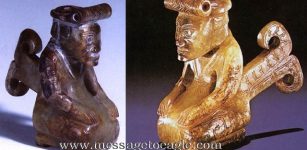Enigma Of Ancient Bell-Shaped Metal Vase Found In Solid Sedimentary Rock – Its Origin Is Unknown
MessageToEagle.com – All across the world puzzling artifacts have been discovered that do not fit the accepted geologic or historical timeline.
Is it possible that modern ways of thinking developed far earlier than we think?
On June 7, 1851 a very interesting appeared in the Scientific American.
The article described the discovery of an object that resembled a silver-zinc vase inlaid with fine silver in the form of the vine. It was embedded within 15 feet of solid sedimentary rock. The age of this vase, according to the rock in which it found supposedly millions of years old.
This remarkable discovery, today known as the Dorchester pot shows ancient people were not just half-ape, half-man creatures sitting in a dark cave, dressed in furs, and lacking the facility of speech.
Were our ancestors more advanced than many modern scientists are willing to admit or did this a strange object simply got embedded in rock by mistake?
The article in the Scientific American entitled “A relic of a by-gone age ” read: ” A few days ago a powerful blast was made in the rock at Meeting House Hill in Dorchester, a few rods south of Rev. Mr. Hall’s meeting house.
The blast threw out an immense mass of rock, some of the pieces weighing several tons and scattered small fragments in all directions.
Among them was picked up a metallic vessel in two parts rent asunder by the explosion.
On putting the two parts together it formed a bell shaped vessel, 4 1/2 inches high, 6 1/2 inches at the base 2 1/2 inches at the top, and about an eighth of an inch thickness.
The body of this vessel resembles zinc in color or a composition metal, in which there is a considerable portion of silver.
On the sides there are six figures of a flower or bouquet beautifully inlaid with pure silver, and around the lower part of the vessel a vine or wreath, inlaid also with silver.
For comparison: image below – an artifact discovered in Dwarkas’ underwater ruins:

The chasing, carving, and inlaying are exquisitely done by the art of some cunning workman.
This curious and unknown vessel was blown out of the solid pudding stone, fifteen feet below the surface.
It is now in the possession of Mr John Kettell. Dr. J.V.C.Smith who has recently traveled in the east and examined hundreds of curious domestic utensils and has drawings of them, has never seen anything resembling this. He has taken a drawing and accurate dimensions of it to be submitted to the scientific community.
There is no doubt but that this curiosity was blown out of the rock, as above stated; but will Professor Agassiz or some other scientific man please to tell us how it came there? The matter is worthy of investigation as there is no deception in the case.”
What later happened to the vase is unclear. The object was stored in a University. It was labeled unknown.
So, what was the origin and nature of the object discovered in 1851? How did an artistic object like this one get buried in limestone?
According to mainstream science, the metal vase is not a vase at all. It was not created by an ancient, lost civilization. Archaeologists identify it as being a recognizable historic artifact, a candlestick of obviously Victorian style.
However, there are also those who see things differently. According to Michael Cremo, author of the best-selling book Forbidden Archaeology – the metal vase discovered in Dorchester evidence for the “presence of artistic metal workers in North America over 600 million years ago.”
Over the centuries, researchers have found bones and artifacts proving that humans like us have existed for millions of years. Mainstream science, however, has suppressed these facts. Prejudices based on current scientific theory act as a ‘knowledge filter’, giving us a picture of prehistory that is largely incorrect.Scientific Establishment Found Guilty of Witholding Evidence
The evolutionists’ “knowledge filter” at work over the last 200 years has left us with a radically altered view of our human origins and antiquity. Since 1993, when the controversial book, Forbidden
Archeology, was first published it has shocked the scientific world with its extensive evidence for extreme human antiquity. It documents hundreds of anomalies in the archeological record that contradict the prevailing theory and shows how this massive amount of evidence was systematically “filtered” out. This book puts all the “pieces” on the table. You can then judge for yourself how objective the scientific community is in its pursuit of knowledge!
‘Forbidden Archeology’ is a remarkably complete review of the scientific evidence concerning human origins. It carefully evaluates all the evidence, including the evidence that has been ignored because it does not fit the dominant paradigm. Anyone can learn a great deal from the authors’ meticulous research and analysis, whatever one concludes about their thesis regarding the antiquity of human beings.”
—Dr. Phillip E. Johnson, University of California, Berkeley, author of Darwin on Trial
Through the years the Dorchester pot has been examined by experts, more recently, last 30 years or so by the Museum of fine Arts in Boston, which operates a state-of-the-art analysis laboratory built in cooperation with M.I.T.
A series of thorough battery of tests were conducted on the object. However, all tests failed to confirm its origin.
We are left with the intriguing and unaswered question – “How did this vase come to be solidly embedded within 15 feet of solid sedimentary rock?”
Copyright © MessageToEagle.com All rights reserved. This material may not be published, broadcast, rewritten or redistributed in whole or part without the express written permission of MessageToEagle.com













